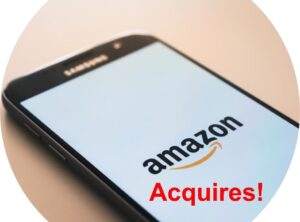Amazon Makes Acquisition, Good for Electrical Distributors
 Last week Amazon made an acquisition, spending $3.9 billion, and it should be very good for electrical distributors.
Last week Amazon made an acquisition, spending $3.9 billion, and it should be very good for electrical distributors.
Why you ask?
Because maybe it will put to rest the ever-ending question of “who will Amazon buy to enter the electrical industry?”
This industry “risk” has been prophesized for a number of years and held as the reason why distributors need to invest in eCommerce and focus on monetizing services (both of which distributors should do but not under fear from Amazon but because it improves their business.)
And to be clear, Amazon does sell electrical materials … to the DIY market as well as to the contractors and industrial accounts. They probably represent .75-1% of total electrical component sales at manufacturer COGS based upon CMG’s projection of the total electrical components market (all channels).
Not insignificant. And this is profitable business for Amazon because it is relatively a low-cost endeavor for them.
Consider, if they wanted to be significantly into the electrical distribution market
- Could they have purchased WESCO years ago when its stock price was “challenged”? Some may even remember the days when it was at $4 a share!
- Could they have purchased Grainger during the pandemic, or prior?
If they can spend $13.7 billion for Whole Foods in 2017, they could acquire WESCO whose market cap is $6 billion today. Which means they could acquire any electrical distributor they want, or acquire a number of them to create their own chain.
But, realistically
- There are other, larger, and potentially more profitable opportunities in the economy, even potentially worldwide, for Amazon to make an investment.
- Getting “deeper” into the electrical market would require Amazon to enter the elements that are more labor intensive (who wants to handle project quotations let alone project management? Do we think that contractors will negotiate commodities with a computer?)
- While Amazon can be great with their fulfillment network, can they handle the last minute needs of contractors and industrial accounts?
- Would they want to handle the above, plus extend credit, for, on average, a 20% gross margin?
- In other words, the electrical distribution market is not a good financial opportunity for Amazon. They can skim some business off the top with their existing software platform that reaches a broad audience, maintain their pricing model and move on to other, bigger opportunities (medical / pharmaceutical, cloud services / tech, etc …)
So, with spending $3.9 billion to acquire One Medical reinforces that Amazon is focused on larger markets that have larger growth opportunities.
Maybe this will put the threat of Amazon entering the electrical industry to rest.
But 1% of the electrical components market is significant. This would enable Amazon to rank in the top 10 in the Electrical Wholesaling Top 150. It would probably make them one of the top 15-20 electrical material resellers in the US.
It shouldn’t be ignored.
Competing and Aligning
Some things to consider …
- From a manufacturer viewpoint, Amazon is legitimate, potentially profitable, channel. There are brand / marketing benefits of being listed and there is a customer segment that electrical distribution does not , probably cannot and/or doesn’t want to serve.
- For enterprising distributors seeking a different sales channel who are willing to invest and who have the right operational platform, may seek to sell selected products through this channel, essentially treating Amazon as “customer”. And, if the model can be developed and perfected, it could then be expanded to other marketplaces with a curated product offering.
- Distributors need to invest into eCommerce (although, if you are reluctant, here’s reasons not to have an eCommerce / eCatalog site) to serve their customers; maybe to increase opportunities in their marketplace. The right investment levels and ROI metrics need to be identified and they need to be scaled to company size and ambition … and be realistic.
- Selling services is also important for a couple of reasons. First of all, identifying the services you offer is an exercise in understanding the value you bring to your customers … and possibly what differentiates you from at least some of your competitors. A services monetization strategy can then be developed enabling you to recoup some of the resources that are invested to provide those services. For some distributors, this may not convert into a “profitable” division, but it could reduce service costs (another definition of profit is a reduction of loss).
- Recognize that every distributor has some, maybe many, customers who purchase something from Amazon. Be open and ask. And ask why and what types of products. Consider it a learning opportunity … and new services and/or new suppliers may be identified.
But, at the end of the day, we can say thank you to Amazon for spending $3.9 billion and putting aside the “threat” that they are going to make an acquisition in the electrical distribution market.
And who knows, maybe Amazon will eventually be a medical provider to “us”?























